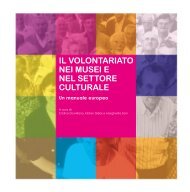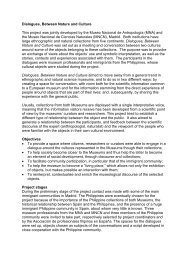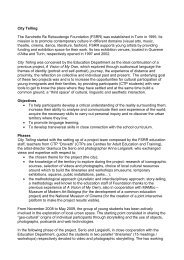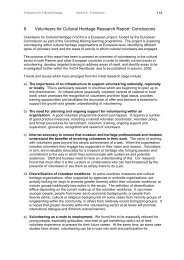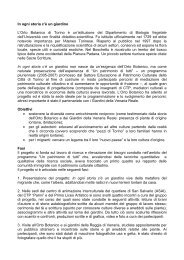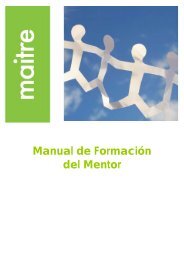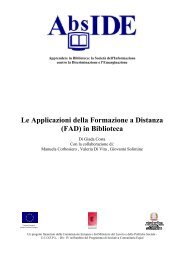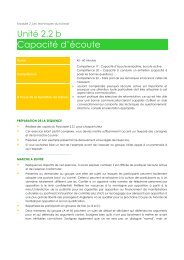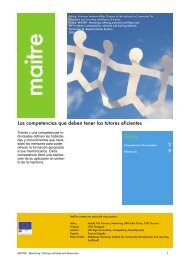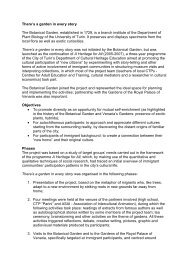Museums as places for intercultural dialogue - Network of European ...
Museums as places for intercultural dialogue - Network of European ...
Museums as places for intercultural dialogue - Network of European ...
Create successful ePaper yourself
Turn your PDF publications into a flip-book with our unique Google optimized e-Paper software.
ForewordChristina KrepsI w<strong>as</strong> first introduced to the <strong>European</strong> project <strong>Museums</strong> <strong>as</strong> Places<strong>for</strong> Intercultural Dialogue (MAP <strong>for</strong> ID) in October 2008 whileteaching a course at the University <strong>of</strong> Bologna on museums andcultural representation. I w<strong>as</strong> drawn to the initiative <strong>for</strong> a number <strong>of</strong>re<strong>as</strong>ons. As an anthropologist, I have been long concerned with therole museums, especially those housing ethnographic collections,can play in promoting cross-cultural understanding and respect<strong>for</strong> human diversity. Hence, the concept <strong>of</strong> using museums <strong>as</strong> avehicle <strong>for</strong> <strong>intercultural</strong> <strong>dialogue</strong> w<strong>as</strong> immediately captivating. I w<strong>as</strong>particularly intrigued by how ethnographic collections were beingused to engage with immigrant communities. For many years now,scholars, museologists, and members <strong>of</strong> source communities havebeen debating the contemporary relevancy <strong>of</strong> ethnographic collectionsand their appropriate use given their nineteenth century origins and<strong>as</strong>sociation with Western colonialism. In the thirty pilot projects carriedout in the framework <strong>of</strong> MAP <strong>for</strong> ID I saw the many innovative andunconventional ways participants are breathing new life into these andother types <strong>of</strong> collections and museums.MAP <strong>for</strong> ID’s focus on working with immigrant and minority communitiesto facilitate more harmonious and just integration addresses a question<strong>of</strong> great social concern not only within <strong>European</strong> societies but also inthe United States. That is: How do we go beyond being multiculturalsocieties to being ‘<strong>intercultural</strong> societies where a plurality <strong>of</strong> culturescooperates in <strong>dialogue</strong> and in shared responsibility.’ 1 This is anoble if not idealistic goal. Indeed, <strong>as</strong> participants in the pilot projectIntercultural Monologues contend, ‘multiculturality is a fact <strong>of</strong> life, but<strong>intercultural</strong>ity is still Utopia.’ The thirty projects presented in this bookshow us that achieving <strong>intercultural</strong>ity is a step by step process thatmay help, with every project and every action, to not only trans<strong>for</strong>m oursocieties but also our museums and the nature <strong>of</strong> public culture.MAP <strong>for</strong> ID exemplifies the ongoing trend within the internationalmuseum community to democratise museums and make them moreaccessible to wider audiences, socially relevant, and responsive totheir publics’ changing needs and interests. The initiative underscoresthe International Council <strong>of</strong> <strong>Museums</strong>’ definition <strong>of</strong> a museum <strong>as</strong> aninstitution ‘in the service <strong>of</strong> society and its development.’ It is one thing,however, to accept this axiom and quite another to put it into actualpractice. The MAP <strong>for</strong> ID projects provide us with concrete models <strong>of</strong>how to utilise the many resources <strong>of</strong> museums, artistic and culturalorganisations to serve contemporary social needs and interests.For example, many projects are devoted to helping immigrantcommunities better integrate into and become familiar with the historyand culture <strong>of</strong> their new home, engendering a sense <strong>of</strong> belongingand shared cultural heritage. Reciprocally, they <strong>of</strong>fer examples <strong>of</strong>how immigrants and other minorities can use these same resourcesto teach their host communities something about their own culture<strong>of</strong> origin. Through this work projects are cultivating new audiencesin addition to finding new ways to re-interpret collections, which inturn, create new purposes and meanings <strong>of</strong> the museum. Of criticalimportance though is how these new audiences are not just seen<strong>as</strong> “visitors” or cultural consumers. They are also cultural producers,participants in the process, decision makers, and protagonists in thecreation and dissemination <strong>of</strong> a new museum discourse and practice.Education and lifelong learning are at the heart <strong>of</strong> the MAP <strong>for</strong> IDinitiative, and education is one <strong>of</strong> the most valuable services museumsand cultural institutions provide society. While many museums inEurope have long placed education at the centre <strong>of</strong> their mission,working to continually improve their outreach and public programming<strong>as</strong> well <strong>as</strong> “visitor services,” others have only taken up this chargerelatively recently. Where<strong>as</strong> in some countries the collection andpreservation <strong>of</strong> objects historically h<strong>as</strong> been the primary focus <strong>of</strong>museums, in others, emph<strong>as</strong>is h<strong>as</strong> shifted to people and the storiesbehind objects and collections. The different orientations <strong>of</strong> museumsand paces <strong>of</strong> change in different countries highlights how museums arealways the product <strong>of</strong> their own unique historical backgrounds, culturalcontexts, and social milieus. As social institutions and part <strong>of</strong> publicculture museums do not exist <strong>as</strong> isolated entities, but embody andreflect the values, attitudes, priorities, and ideologies <strong>of</strong> the societies inwhich they exist. If they are dynamic institutions, museums also evolvein response to changes taking place outside their walls. But MAP <strong>for</strong> IDprojects clearly illustrate how museums and other cultural organisationsdo not just mirror societal changes. They can also help shape them <strong>as</strong>agents <strong>of</strong> change themselves.MAP <strong>for</strong> ID is in itself an instructive c<strong>as</strong>e study in <strong>intercultural</strong> <strong>dialogue</strong>and international cooperation, comprised <strong>of</strong> participants from sixcountries representing a wide range <strong>of</strong> cultural, artistic, scientific, andeducational organisations. The pilot projects demonstrate what canbe achieved through collective action devoted to a common causeon relatively small budgets. They should be an inspiration to anyoneinterested in developing participatory approaches to making museums,cultural organisations, events, artistic per<strong>for</strong>mances, and cultural workin general more inclusive and multi-vocal.I have been honored to be invited to participate in this exciting andpr<strong>of</strong>oundly important initiative. From an anthropological perspective,MAP <strong>for</strong> ID is a f<strong>as</strong>cinating c<strong>as</strong>e study on the relationship betweenmuseums and the social and cultural changes taking place in <strong>European</strong>societies. But <strong>as</strong> both a museum theorist and practitioner, MAP <strong>for</strong>ID is <strong>of</strong> more than academic interest to me. I am also concernedwith exploring how MAP <strong>for</strong> ID approaches to <strong>intercultural</strong> <strong>dialogue</strong>,especially with immigrant communities, can be applied to museumsin my hometown <strong>of</strong> Denver, Colorado. Although Denver and <strong>European</strong>cities have very different historical experiences related to immigrationand integration, we are all currently sharing similar challenges. It is myhope that I can carry the philosophy and spirit <strong>of</strong> MAP <strong>for</strong> ID across theAtlantic and continue broadening its scope <strong>of</strong> international cooperationand exchange.1From <strong>European</strong> Commissioner Ján Figel’s address during the launch <strong>of</strong> the <strong>European</strong>Year <strong>of</strong> Intercultural Dialogue 2008 in Slovenia.4 5



